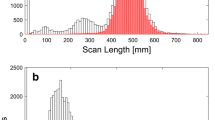Abstract
The Australian Radiation Protection and Nuclear Safety Agency (ARPANSA) is undertaking web based surveys to obtain data to establish national diagnostic reference levels (DRLs) for diagnostic imaging. The first set of DRLs to be established are for multi detector computed tomography (MDCT). The survey samples MDCT dosimetry metrics: dose length product (DLP, mGy.cm) and volume computed tomography dose index (CTDIvol, mGy), for six common protocols/habitus: Head, Neck, Chest, AbdoPelvis, ChestAbdoPelvis and Lumbar Spine from individual radiology clinics and platforms. A practice reference level (PRL) for a given platform and protocol is calculated from a compliant survey containing data collected from at least ten patients. The PRL is defined as the median of the DLP/CTDIvol values for a single compliant survey. Australian National DRLs are defined as the 75th percentile of the distribution of the PRLs for each protocol and age group. Australian National DRLs for adult MDCT have been determined in terms of DLP and CTDIvol. In terms of DLP the national DRLs are 1,000 mGy cm, 600 mGy cm, 450 mGy cm, 700 mGy cm, 1,200 mGy cm, and 900 mGy cm for the protocols Head, Neck, Chest, AbdoPelvis, ChestAbdoPelvis and Lumbar Spine respectively. Average dose values obtained from the European survey Dose Datamed I reveal Australian doses to be higher by comparison for four out of the six protocols. The survey is ongoing, allowing practices to optimise dose delivery as well as allowing the periodic update of DRLs to reflect changes in technology and technique.








Similar content being viewed by others
References
Hart D, Hillier MC, Wall BF (2009) National reference doses for common radiographic, fluoroscopic and dental X-ray examinations in the UK. Br J Radiol 82(973):1–12
Wall BF (2005) Implementation of DRLs in the UK. Radiat Prot Dosimetry 114(1–3):183–187
Wall BF (2001) Diagnostic reference levels—the way forward. Br J Radiol 74(885):785–788
Commission E (1997) Council Directive 97/43/EURATOM of 30 June 1997 on health protection of individuals against the dangers of ionising radiation in relation to medical exposure, and repealing Directive 84/466/Euratom. Off J Eur Communities L180:40
Services AGDoH. Medicare benefits schedule. MBS statistics 2010. (cited 2011). http://www.medicareaustralia.gov.au/provider/medicare/mbs.jsp#N10030
Commission E (2008) European guidance on estimating population doses from medical X-ray procedures. Radiation protection no 154
Bongartz G, Golding S, Jurik A, Leonardi M, van Persijn van Meerten E, Rodriguez R et al (2004) European guidelines on quality criteria for computed tomography. Funded by the European Commission
Shrimpton PC, Hillier MC, Lewis MA, Dunn M (2006) National survey of doses from CT in the UK: 2003. Br J Radiol 79(948):968–980
Conover WJ (1971) Practical nonparametric statistics. Wiley, New York
McCollough C, Branham T, Herlihy V, Bhargavan M, Robbins L, Bush K et al (2011) Diagnostic reference levels From the ACR CT accreditation program. J Am Coll Radiol 8(11):795–803
Compagnone G, Pagan L, Bergamini C (2005) Local diagnostic reference levels in standard X-ray examinations. Radiat Prot Dosimetry 113(1):54–63
Wallace AB, Goergen SK, Schick D, Soblusky T, Jolley D (2010) Multidetector CT dose: clinical practice improvement strategies from a successful optimization program. J Am Coll Radiol 7(8):614–624
Acknowledgments
The Authors would like to thank every practice that has participated in the survey to date.
Author information
Authors and Affiliations
Corresponding author
Rights and permissions
About this article
Cite this article
Hayton, A., Wallace, A., Marks, P. et al. Australian diagnostic reference levels for multi detector computed tomography. Australas Phys Eng Sci Med 36, 19–26 (2013). https://doi.org/10.1007/s13246-013-0180-6
Received:
Accepted:
Published:
Issue Date:
DOI: https://doi.org/10.1007/s13246-013-0180-6




